Painter of early murals returns to the heart of Derry’s cultural scene
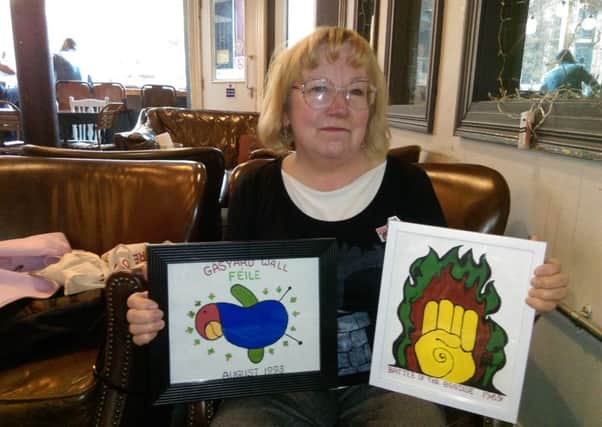

Arlene went on to leave her own mark as a muralist, artist and actress whilst living in the heart of Derry during those final years of the ‘Troubles,’ and was responsible for painting and helping to paint some of the most iconic murals of the era.
Her experiences here, in turn, left such an indelible mark that Arlene returned to live in Derry permanently two years ago and she has wasted no time getting back into the heart of the still thriving cultural scene.
Advertisement
Hide AdAdvertisement
Hide AdSpeaking to the ‘Journal,’ Arlene, who grew up in England before spending much of her life in New York City and State, said: “I came to Derry 30 years ago. It was on a Noraid tour. We travelled around the Six Counties; stayed in people’s homes, learning first hand as the ‘Troubles’ were still going on. It was really eye-opening; mind boggling; life-changing.
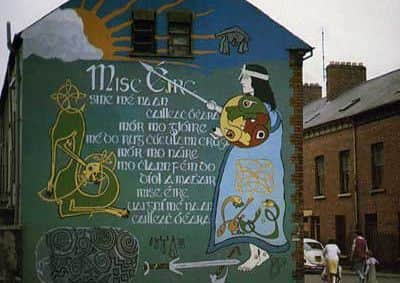

“All those places were wonderful and all those people were fantastic, but when that bus travelled over the Craigavon Bridge, I knew I was home. No explanation, that’s it. So I kept coming back and forth for 28 years. I hadn’t been to Ireland before that trip and something just clicked.”
Arlene said the city was very different back then, parts of it razed to the ground with bomb damaged buildings and cars. “I lived in the Bog and in the Brandywell and I experienced raids in the homes I was living in.
“I was shot at - wrong place, wrong time - but I knew from the people I met, especially the young people, that if the ‘Troubles’ could finish, I saw the seeds of this amazing beautiful flower that was going to blossom if given the chance.”
Threw airline ticket away
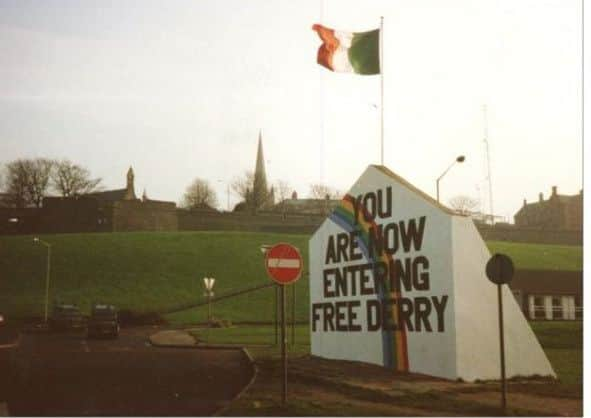

Advertisement
Hide AdAdvertisement
Hide Ad“Then what also drew me was in 1989, that summer, there was something called the 20/20 Vision festival- there was a 100 ft banner, 10x10 foot panels, two sided, designed by the young people of the town. Then there was a play written about the women on hunger strike, worked on by the young people in collaboration, and I, being an actress and artist, I saw this festival coming together. I was so moved. I was supposed to fly back to America and I couldn’t do it. I threw away my airline ticket to stay for the festival. I had to. That festival was really in the middle of the ‘Troubles,’ when nobody had anything but they found a way to make this happen. It was music and workshops for kids, and I knew I could plug in. Derry being Derry the wee American walks up to them and says, ‘hey can I help?’ And they go ‘OK’ and that was that.”
The following year Arlene returned and stayed three months. As a photographer she brought with her hundreds of rolls of films, and “documented; had adventures; met more people; worked with women; worked with children and painted murals.”
Arlene said that at the time the murals were described to her as “the newspapers of the street.” She reckons that one of the reasons she was ‘allowed’ to paint murals (‘I say allowed because it was such an honour’) was that because the others were mostly young men from the area, as a woman from America she was somewhat off limits as far as the security forces went. “If the Brits or Cops came around, the young people were gone. I stayed on the ladder. The Brits had no idea what to do with a teeny American blonde painting away, so I just kept painting. So whenever murals had to be done, I was the person to go to.”
So much so, in fact that Arlene’s name is the first to be mentioned among those acknowledged in the acclaimed book ‘Murals of Derry’ published by Guildhall Press.
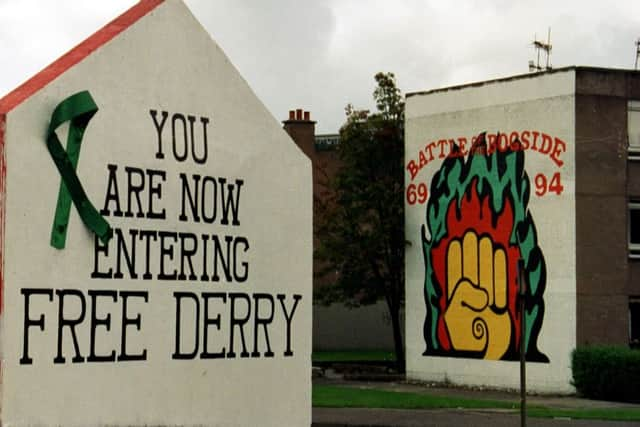

Advertisement
Hide AdAdvertisement
Hide AdShe stresses that she did not design any murals, as she did not think that was her place as an American, but was active in painting them.
One of the most famous of those murals, she worked on, she worked on alone. The yellow fist emerging from a flame commemorating the ‘Battle of the Bogside’ would become iconic. Recalling its creation, she said: “No-one was in town, I don’t know where they were. They gave me the gear and said ‘carry on.’ It was a Sunday. It was painted in 1994, the 25th anniversary. I spent the day and painted the mural. Someone comes to my door next day looking really sheepish, I asked what was up and he said, ‘The mural, it’s grand, really good... it’s too small’. I painted it again. I had to do it twice, I think I might be the only person who has ever had to paint the same mural twice.”
Arlene recalls having to ‘holler’ for her boyfriend to get a relative to come up on the scaffolding to finish painting the letters at the top of the mural as she couldn’t reach the last bit. “There were no cell phones so I’m shouting to him to get his brother in law,” she laughs.
Arlene also worked on other murals, including helping restore the now gone iconic murals at the Rossville Street/Chamberlain Street junction, and painting one in Creggan showing a map of Ireland with the north being sewn back on to the rest of the country and a purple mural on political prisoners. Arlene said she wanted to pay tribute to Seamus McCloskey, who passed away earlier this year. “He worked on a lot of the murals and he is missed,” she said.
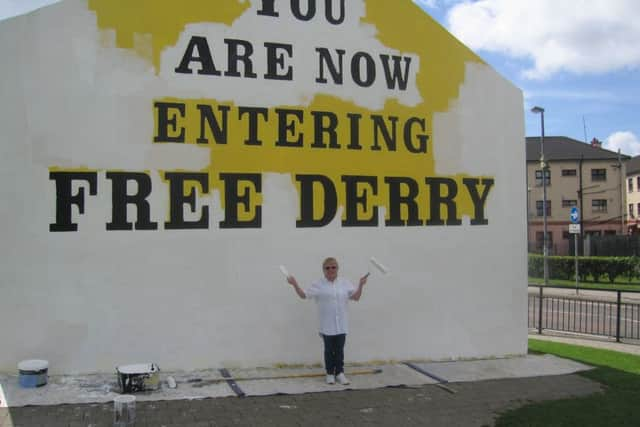

Advertisement
Hide AdAdvertisement
Hide AdWhile having helped paint Free Derry Wall over the years, including a rainbow for Gay Pride and international solidarity back in the 1990s, Arlene is in agreement with many in Derry that the front of Free Derry Corner shouldn’t be changed.
“Yer man Patrick Coyle came up with the idea of putting the board on the back of the Wall and that can be changed so easily,” she said.
BLOODY SUNDAY INITIATIVE
Arlene met a fellow American who happened to be in Derry the year they did the rainbow mural at Free Derry in the 1990s. “This guy, quite by chance, had arrived in Derry the day after Bloody Sunday so he has even a deeper connection to the city.
“He took a photograph of the mural and he and I and two men in California worked to have posters made of it to benefit both the Bloody Sunday Initiative as it was at that time and the Pat Finucane Centre which was started at that time, and I had the honour of being at the founding of both of those in 1990s and was able to be a spokesperson for both in America and at peace conferences.
Advertisement
Hide AdAdvertisement
Hide Ad“We were all on the phone all over America selling these posters and shipping them out and we brought a whole bunch back here to sell. It was a bit of a challenge.”
Arlene also worked with the Gasyard “before there was a Gasyard.” For the first ever Feile in 1993, she got fabric paint and did T-shirts for a couple of bob promoting the event. “We got the T-shirts for a pound. Frankie McMenamin who was one of the first people I met in Derry and became friends with still has one of the T-shirts.”
To mark the 50th anniversary of the Battle of the Bogside, Arlene is creating mini artwork replicas of the Battle of the Bogside mural she painted back in 1994 with funds going to the Museum of Free Derry, where she is now a volunteer.
She says feels like coming full circle. “Of all the things I’ve been doing, working at the Museum means a lot.”
DERRY THEN AND NOW
Advertisement
Hide AdAdvertisement
Hide AdArlene said she had not been fully aware of the situation here and came to Ireland with “a pretty blank slate.” In fact, she said, she knew nothing of politics at all until she agreed to go to Nicaragua on an earlier trip back in the 80’s despite initial reluctance, including not knowing where it was.
“That got me politically aware. I got back to America, I learned more, Then I went to Cuba, learned more, then a friend said, ‘Hey there’s a trip that goes to Ireland very similar to the one...’ I thought that would be a great idea, I can go on one of these trips where I actually speak the language. What a concept! So I signed up for the trip and the next year I was one of the organisers. It was two huge buses. I’ll never forgot being lost somewhere in Fermanagh and the back of the coach opened up and all these suitcases fell out on this back country road. We had some good adventures.”
Arlene said that staying in people’s homes gave her an insight into what people here were going through at that time.
Now returning she has seen some differences, although the very real social problems like the lack of jobs and high suicide rate have not escaped her attention. “When I got the opportunity to come back here a few years ago my goal was to give back to Derry what Derry has given to me. I stopped coming here in ‘98, I missed the Celtic Tiger, a lot of things so it was a huge change when I came back in 2011. I was really gobsmacked there was cell phones, computers, and I just had to step back and talk to people and say has it really changed? Is there work now? It’s really pleasant but people don’t have jobs or they are all in call centres,” she said.
Advertisement
Hide AdAdvertisement
Hide AdSpeaking about Derry and the changed political landscape of today, Arlene said: “I’m a positive, hopeful kind of person and I saw back then that the people of Ireland in general were determined, they were passionate, but they had such integrity, they wanted to go about it in an honourable way. Bloody Sunday started as a peaceful civil rights demonstration and I saw lots of integrity and very intelligent people, including some men, some women as well, who were in prison for 17 years, who were able to teach each other Irish, they showed us notebooks were they learned economics. I knew these people would succeed.”
She is glad that the artscene remains vibrant locally today and she has become involved with various organisations and projects including acting, environmental campaigns and groups, North West Carnival Initiative and Sole Purpose Productions, all of which she praises. “There’s nothing like the scene here,” she said. “I’m 21 years in New York and it gives it a run for the money definitely!”